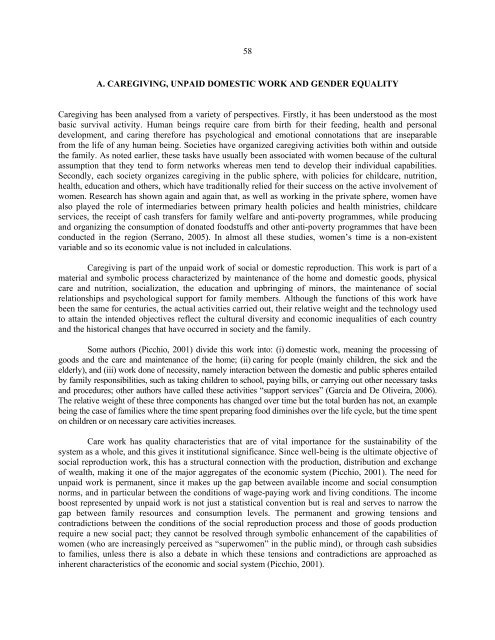Women in Latin America and the Caribbean - Cepal
Women in Latin America and the Caribbean - Cepal
Women in Latin America and the Caribbean - Cepal
You also want an ePaper? Increase the reach of your titles
YUMPU automatically turns print PDFs into web optimized ePapers that Google loves.
58<br />
A. CAREGIVING, UNPAID DOMESTIC WORK AND GENDER EQUALITY<br />
Caregiv<strong>in</strong>g has been analysed from a variety of perspectives. Firstly, it has been understood as <strong>the</strong> most<br />
basic survival activity. Human be<strong>in</strong>gs require care from birth for <strong>the</strong>ir feed<strong>in</strong>g, health <strong>and</strong> personal<br />
development, <strong>and</strong> car<strong>in</strong>g <strong>the</strong>refore has psychological <strong>and</strong> emotional connotations that are <strong>in</strong>separable<br />
from <strong>the</strong> life of any human be<strong>in</strong>g. Societies have organized caregiv<strong>in</strong>g activities both with<strong>in</strong> <strong>and</strong> outside<br />
<strong>the</strong> family. As noted earlier, <strong>the</strong>se tasks have usually been associated with women because of <strong>the</strong> cultural<br />
assumption that <strong>the</strong>y tend to form networks whereas men tend to develop <strong>the</strong>ir <strong>in</strong>dividual capabilities.<br />
Secondly, each society organizes caregiv<strong>in</strong>g <strong>in</strong> <strong>the</strong> public sphere, with policies for childcare, nutrition,<br />
health, education <strong>and</strong> o<strong>the</strong>rs, which have traditionally relied for <strong>the</strong>ir success on <strong>the</strong> active <strong>in</strong>volvement of<br />
women. Research has shown aga<strong>in</strong> <strong>and</strong> aga<strong>in</strong> that, as well as work<strong>in</strong>g <strong>in</strong> <strong>the</strong> private sphere, women have<br />
also played <strong>the</strong> role of <strong>in</strong>termediaries between primary health policies <strong>and</strong> health m<strong>in</strong>istries, childcare<br />
services, <strong>the</strong> receipt of cash transfers for family welfare <strong>and</strong> anti-poverty programmes, while produc<strong>in</strong>g<br />
<strong>and</strong> organiz<strong>in</strong>g <strong>the</strong> consumption of donated foodstuffs <strong>and</strong> o<strong>the</strong>r anti-poverty programmes that have been<br />
conducted <strong>in</strong> <strong>the</strong> region (Serrano, 2005). In almost all <strong>the</strong>se studies, women’s time is a non-existent<br />
variable <strong>and</strong> so its economic value is not <strong>in</strong>cluded <strong>in</strong> calculations.<br />
Caregiv<strong>in</strong>g is part of <strong>the</strong> unpaid work of social or domestic reproduction. This work is part of a<br />
material <strong>and</strong> symbolic process characterized by ma<strong>in</strong>tenance of <strong>the</strong> home <strong>and</strong> domestic goods, physical<br />
care <strong>and</strong> nutrition, socialization, <strong>the</strong> education <strong>and</strong> upbr<strong>in</strong>g<strong>in</strong>g of m<strong>in</strong>ors, <strong>the</strong> ma<strong>in</strong>tenance of social<br />
relationships <strong>and</strong> psychological support for family members. Although <strong>the</strong> functions of this work have<br />
been <strong>the</strong> same for centuries, <strong>the</strong> actual activities carried out, <strong>the</strong>ir relative weight <strong>and</strong> <strong>the</strong> technology used<br />
to atta<strong>in</strong> <strong>the</strong> <strong>in</strong>tended objectives reflect <strong>the</strong> cultural diversity <strong>and</strong> economic <strong>in</strong>equalities of each country<br />
<strong>and</strong> <strong>the</strong> historical changes that have occurred <strong>in</strong> society <strong>and</strong> <strong>the</strong> family.<br />
Some authors (Picchio, 2001) divide this work <strong>in</strong>to: (i) domestic work, mean<strong>in</strong>g <strong>the</strong> process<strong>in</strong>g of<br />
goods <strong>and</strong> <strong>the</strong> care <strong>and</strong> ma<strong>in</strong>tenance of <strong>the</strong> home; (ii) car<strong>in</strong>g for people (ma<strong>in</strong>ly children, <strong>the</strong> sick <strong>and</strong> <strong>the</strong><br />
elderly), <strong>and</strong> (iii) work done of necessity, namely <strong>in</strong>teraction between <strong>the</strong> domestic <strong>and</strong> public spheres entailed<br />
by family responsibilities, such as tak<strong>in</strong>g children to school, pay<strong>in</strong>g bills, or carry<strong>in</strong>g out o<strong>the</strong>r necessary tasks<br />
<strong>and</strong> procedures; o<strong>the</strong>r authors have called <strong>the</strong>se activities “support services” (García <strong>and</strong> De Oliveira, 2006).<br />
The relative weight of <strong>the</strong>se three components has changed over time but <strong>the</strong> total burden has not, an example<br />
be<strong>in</strong>g <strong>the</strong> case of families where <strong>the</strong> time spent prepar<strong>in</strong>g food dim<strong>in</strong>ishes over <strong>the</strong> life cycle, but <strong>the</strong> time spent<br />
on children or on necessary care activities <strong>in</strong>creases.<br />
Care work has quality characteristics that are of vital importance for <strong>the</strong> susta<strong>in</strong>ability of <strong>the</strong><br />
system as a whole, <strong>and</strong> this gives it <strong>in</strong>stitutional significance. S<strong>in</strong>ce well-be<strong>in</strong>g is <strong>the</strong> ultimate objective of<br />
social reproduction work, this has a structural connection with <strong>the</strong> production, distribution <strong>and</strong> exchange<br />
of wealth, mak<strong>in</strong>g it one of <strong>the</strong> major aggregates of <strong>the</strong> economic system (Picchio, 2001). The need for<br />
unpaid work is permanent, s<strong>in</strong>ce it makes up <strong>the</strong> gap between available <strong>in</strong>come <strong>and</strong> social consumption<br />
norms, <strong>and</strong> <strong>in</strong> particular between <strong>the</strong> conditions of wage-pay<strong>in</strong>g work <strong>and</strong> liv<strong>in</strong>g conditions. The <strong>in</strong>come<br />
boost represented by unpaid work is not just a statistical convention but is real <strong>and</strong> serves to narrow <strong>the</strong><br />
gap between family resources <strong>and</strong> consumption levels. The permanent <strong>and</strong> grow<strong>in</strong>g tensions <strong>and</strong><br />
contradictions between <strong>the</strong> conditions of <strong>the</strong> social reproduction process <strong>and</strong> those of goods production<br />
require a new social pact; <strong>the</strong>y cannot be resolved through symbolic enhancement of <strong>the</strong> capabilities of<br />
women (who are <strong>in</strong>creas<strong>in</strong>gly perceived as “superwomen” <strong>in</strong> <strong>the</strong> public m<strong>in</strong>d), or through cash subsidies<br />
to families, unless <strong>the</strong>re is also a debate <strong>in</strong> which <strong>the</strong>se tensions <strong>and</strong> contradictions are approached as<br />
<strong>in</strong>herent characteristics of <strong>the</strong> economic <strong>and</strong> social system (Picchio, 2001).











